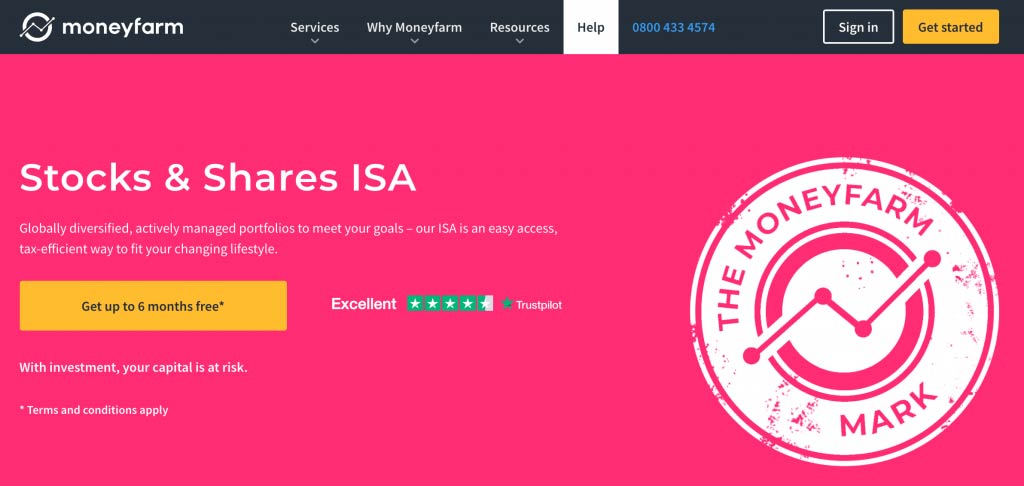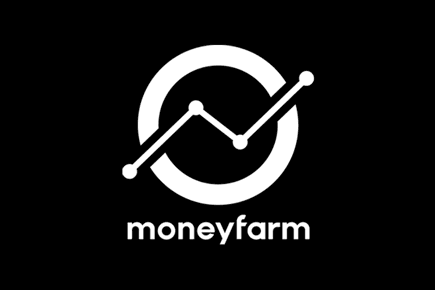In this Moneyfarm review, I’ve taken a close look at the investment platform, what they offer investors, how competitive their fees are, and whether their portfolios are generating good returns compared to other providers.
Make sure you read on to find out why Moneyfarm made it onto my list for Best ‘Set it and Forget It’ Stocks and Shares ISA as well as my Top Five Robo Advisors for UK Investors.
Get up to £500 investment boost*
Beat inflation with an up to £500 investment boost in our most generous cashback offer. Any investment into any Moneyfarm product counts towards your total. Simply invest before the 28th October 2022 and they will do the rest.
Moneyfarm is one of the many, relatively new, robo adviser investing platforms on the market, providing digital financial advice using complex algorithms. This furnishes casual investors with the opportunity to grow their wealth with minimal human intervention, and therefore at a fraction of the cost of a traditional financial advisor.
The originally Italian-based company branched out into the UK in early 2016 and is authorised and regulated by the Financial Conduct Authority. They’re also backed by the Financial Services Compensation Scheme meaning that anything you invest with them up to £85,000 is protected.
- Moneyfarm Ratings
- Who is Moneyfarm?
- MoneyFarm Product Range
- Moneyfarm Socially Responsible Portfolios
- Moneyfarm Fixed Allocation Portfolio
- Moneyfarm Portfolio Performance
- Research Services & Tools
- Moneyfarm Fees
- Moneyfarm ISA Review
- Moneyfarm Junior ISA review
- Moneyfarm SIPP Review
- Moneyfarm FAQs
- Moneyfarm Customer reviews
Moneyfarm Ratings
Overall
Pros
- Best for “set-and-forget” investors
- Diversification opportunities within your investment
- Everything is done for you once you specify your risk tolerance and time horizon
Cons
- Limited number of portfolios available
- Not the best option for experienced investors
Who is Moneyfarm?
Moneyfarm is one of the largest digital wealth management companies in Europe offering low-cost investment solutions to over 50,000 active users and managing over £1 billion in investments.
Moneyfarm currently offer a Stocks and Shares ISA, SIPP and General Investment Account. Their investment approach is to present clients with 7 different portfolios, varying in risk, that are invested across a range of financial instruments (although their asset allocation is mainly in ETFs).
Their portfolios have all performed generally well over the last 4 years they’ve been operating here in the UK and give investors solid annual returns. Moneyfarm fees and annual charges are competitive for the kind of service they are offering (more of a ‘done for you’ product) and they have a great customer service team and wealth managers on hand to help you with any questions you may have prior to signing up.
Who Owns Moneyfarm?
Moneyfarm was founded by current Chairman Paolo Galvani and Executive Officer Giovanni Dapra. Today they are backed by significant investors including United Ventures, Cabot Square Capital, Allianz, and Poste Italiane.
MoneyFarm Product Range
Moneyfarm offers their investors three primary investment accounts made up of a Stocks and Shares ISA, a SIPP and a General Investment Account and you have the option to invest your money in a choice of 7 portfolios. Each portfolio has a number associated with it; 1 being the lowest risk level and 7 the highest.
What’s important to consider here is the way Moneyfarm matches you with the risk profile that they deem to be the most appropriate for your unique circumstances. This is done using an in-house risk assessment which is conducted via a comprehensive questionnaire. Some of the questions you can expect to encounter include details of your investment experience as well as your investment views when it comes to risk.
On the back of the answers you provide, Moneyfarm will match you to one of their portfolios. This process of matching you with the appropriate portfolio is considered regulated investment advice and is therefore ongoing throughout your investment journey with Moneyfarm. FCA guidelines dictate that Moneyfarm are required to review this financial advice annually, updating its recommendations in line with your changing circumstances.
Now to take a closer look at what makes up each of these portfolios.
Moneyfarm have used low-cost Exchange-Traded Funds (ETFs) and used volatility targeting when allocating assets. Your funds will be spread across the following investment options:
- Cash
- Cash & Short Term Government Bonds
- Developed Markets Government Bonds
- Inflation-Linked Bonds
- Investment Grade Credit
- Investment Grade Corporate Bonds
- High Yield Credit & Emerging Markets Government Bonds
- Developed Markets Equities
- Emerging Market Equities
- Commodities and Real Estate
The exact allocation of the assets within your portfolio are all detailed on the Moneyfarm website.
As part of their product summary, Moneyfarm is also transparent about the different countries where your funds will be invested. Obviously, this varies depending on your risk profile. For example, those with a low-risk portfolio (1), will have 66% of their funds invested in the UK markets with nothing being invested in emerging countries and commodities. However, if you have the highest risk portfolio (7), just 11% of your funds will be in UK markets and 13% will be invested in emerging countries; 50% will also be invested in the US stock market when choosing the high-risk portfolio.
The asset allocation within your portfolio is also actively managed by a team of investment specialists who conduct regular market analysis, daily asset trading and performance tracking in order to ensure your portfolio is always optimised.
One of the aspects I liked about the service at Moneyfarm was the addition of a dedicated consultant. Your consultant can be reached by phone or chat and brings a personal touch to what could have otherwise been a robotic and impersonal service.
One of the more recent additions to Moneyfarm is the ability to invest in more than one portfolio within the same account, at the same time. This is a great option for those who are on the cusp of two portfolios, or for those who wish to diversify even further.
Whilst there is no historical data to support the returns of their SRI offering, Moneyfarm have conducted a simulation of the performance which shows that from 2013 to 2021, the most adventurous SRI portfolio would have earned 5% more than their regular non-ESG portfolio. As with the non-ESG portfolios, Moneyfarm can match your risk profile to the best SRI portfolio for you, ensuring that you are not taking on more risk than you are comfortable with.
This is a very welcome addition and completes Moneyfarm’s investment offering.
You can view more on Socially Responsible Investing from Moneyfarm in their video below.
Moneyfarm Fixed Allocation Portfolio
The Moneyfarm fixed allocation portfolios were launched in September 2022 and offer investors long-term investment for less cost. This is because, unlike the actively managed portfolios, fixed allocation looks at historical data in order to put together a portfolio that is designed to achieve long-term growth with minimal intervention from the investment team.
This is a hands-off approach to investing and whilst it is designed for the long term (minimum five years), investors can access their funds at any time. These fixed allocation portfolios can also be built in a socially responsible way so they fit with your values.
There are 5 risk levels available, and the cost is reduced from 0.35% to 0.25% depending on the portfolio you choose. This means that on a £20,000 investment, you could save up to £15.83 per month on management fees.
Moneyfarm Portfolio Performance
Moneyfarm have achieved great results with their actively managed portfolios, achieving a return of 50.3% on their Level 6 portfolio between January 2016 and January 2021. However, you need to compare this with their competitors in order to get an idea of where they sit in the robo adviser space. To this end, I have placed the performance of their portfolio side by side with that of Nutmeg who are currently the largest robo adviser in the UK comparing the 2019 and 2020 Moneyfarm portfolio returns with that of Nutmeg.
| Provider | Portfolio | % return 2019 after fees | % return 2020 after fees | Total |
|---|---|---|---|---|
| Nutmeg | SRI* Level 6 | 15.10 | 9.3 | 24.4 |
| Nutmeg | SRI* Level 7 | 17.2 | 9.2 | 26.4 |
| Nutmeg | Level 7 | 15.0 | 6.3 | 21.3 |
| Moneyfarm | Level 6 | 16.50 | 6.10 | 22.6 |
| Moneyfarm | Level 5 | 14.4 | 4.5 | 18.9 |
*SRI – Socially Responsible Investing
Whilst Moneyfarm may be trailing slightly behind Nutmeg, the past performance of their level 6 portfolio in 2019 was unmatched so it’s important to remember that these results are constantly moving and past performance is merely an indicator but is no guarantee of future results. Regardless, these are still great returns. It is also worth remembering that the investment market for 2020 was very volatile with the FTSE 100 falling by 14.3%, its greatest decline since 2008.
The key takeaway here is that ethical portfolios seem to be pulling ahead in recent years. This is where Moneyfarm look to be catching up with Nutmeg with the recent launch of their SRI portfolios.
Research Services & Tools
Moneyfarm is effectively a ‘done for you’ kind of service, where you don’t have the flexibility to create your own bespoke portfolio. This means that you won’t see the usual research and analysis tools you may come across with other investment service providers. Nevertheless, they still provide a wealth of information for their clients on their website.
Their ‘Insights’ section features a regularly updated blog where you can easily filter by topic; Financial markets, Investment products, Behavioural economics, Financial planning and, for anyone new to investing out there, Investing 101, where they fill you in on everything from the basics of compound interest to inflation, equity and even GDP. This is a great resource from which to learn about investment and personal finance.
I particularly like their eBooks section which currently features 7 in-depth guides to interesting finance-based topics such as retiring early, FinTech and investing in the buy-to-let industry.
Finally, they also have a useful pension calculator tool to help you work out exactly how much you need to save for retirement. Unsurprisingly, studies have found that young people, especially millennials currently don’t know how much they need to save for a fruitful retirement and those who gauge a guess usually come in with numbers far lower than what they’re actually going to need.
The tool is set out very simply, you put in your current age, desired retirement age, current pension pot value and your desired annual income at retirement and it’ll calculate how much you need to be putting in there each month – you also have the option of whether to include your state pension as part of the calculations or not.
Moneyfarm Fees
Like many other self-directed platforms, Moneyfarm investments operate a sliding scale fee structure which you can check out here to calculate the exact pound amount you’d be paying based on your annual investment.
Their management fees are essentially broken up into two parts; the costs and charges associated with providing their service (the Moneyfarm Management Fee) and the costs and charges relating to the financial instruments they invest in (Underlying Fund Fee and Market Spread).
Moneyfarm Investments Management Fees
Essentially this is Moneyfarm’s platform fee. This annual fee is calculated on a sliding scale with seven tiers depending on your total pot.
| Investment Threshold (Overall Account) |
New Management Fee (On the entire balance) |
Fixed Allocation Portfolio |
|---|---|---|
| From £500 | 0.75% | 0.45% |
| From £10,000 | 0.70% | |
| From £20,000 | 0.65% | |
| From £50,000 | 0.60% | |
| From £100,000 | 0.45% | 0.35% |
| From £250,000 | 0.40% | 0.30% |
| From £500,000 | 0.35% | 0.25% |
Although this is a much higher fee structure than that of more bespoke self-directed services like Hargreaves Lansdown, Charles Stanley and AJ Bell, this is due to the fact that it’s a done-for-you service. If we compare it to a similar product, like that of Moneybox, for example, you can see that the fees are more aligned and that they’re actually pretty competitive, especially when you get to the £100,000 mark. Having said that, by this point in your investing journey, you may want to consider developing a personalised portfolio with one of the old-school providers.
Underlying Fund Fee
Moneyfarm primarily invests in Exchange Traded Funds and this is the fund fee associated with those particular instruments. With Moneyfarm, this comes in at an average of 0.2%.
Market Spread
Otherwise known as the cost of the transaction and can vary depending on where and when Moneyfarm makes your investment. The cost is an annual average of 0.10%
Trading and Other Fees
The great thing about the done for you service and this transparent pricing structure is that there are no additional subscription fees to use the service and no trading fees, which with other providers can cost up to £13.95 per trade (and sometimes even more).
Pension Fees
Moneyfarm’s pension fee structure is the same as that for their stocks and shares ISA account and General Investment Account which I discussed above. They also base their fees on your total funds across all accounts, not just one. Another great thing is they don’t charge you any kind of admin fee for drawdowns on your pension account either, which, depending on the value of the pot, could see you saving hundreds per year compared to some other mainstream providers.
Moneyfarm ISA Review
Starting a stocks and shares ISA with Moneyfarm is a great way for you to dip your toes in a tax-free wrapper when it comes to the world of investments. However, Moneyfarm’s minimum deposit (or transfer-in) is £500. Unlike other major players like HL, AJ Bell and Fidelity, where you can start with as little as £25 and set up a monthly direct debit contribution.
Their stocks and shares ISA product, however, is flexible and you can withdraw funds and replace them in the same year without eating away at your ISA allowance.

In terms of performance, however, generally, their customers are happy with their ROI which has shown steady long term gains since the company established their UK branch in 2016. As with any investment, there comes an associated risk but they’ve rarely seen poor figures. Their ultra-cautious portfolio doesn’t make you that much more than what some high-rate savings accounts would bring in (though they are usually limited to a low amount) and over the last 12 months they’ve made particularly solid returns of 3.38%.
On the opposite side of the spectrum, their riskiest portfolio has made gains of 16.72% in the last 12 months and averaged an annualised return of 12.4% since 2016 which is pretty impressive considering the slump that most people faced in 2018.
Moneyfarm Junior ISA review
Moneyfarm now offer a Junior ISA, giving parents and carers a tax efficient way to invest for their children. You can contribute up to £9,000 a year and not pay any income tax on the gains made. Exactly the same investments are available such as the classic, fixed allocation and socially responsible portfolios and this kind of long-term strategy can help build a nest egg for your little one.
Moneyfarm SIPP Review
Moneyfarm’s SIPP product is invested in the same funds as their ISA portfolios so the numbers and expected returns we discussed in the ISA review apply here too.
SIPPs are a great tax-free way to save for your retirement while getting a boost of 25% from the government too – and who doesn’t like free money. The great thing about the Moneyfarm Pension plans is that they also allow your employer to contribute to your pension pot too.
The fact that Moneyfarm mainly invests in ETFs means that they can keep the fund fees relatively low which is good for those who have lower pension pots and being a Robo-advisor investment service comes with some pros too. Although there are some great financial advisors out there, we can all make mistakes, and worse yet some advisors are known to not really look out for their client’s interests, but their own pockets instead resulting in poor gains for customers.
Overall their SIPP product is ideal for someone who’s just thinking about starting out a pension fund of their own.
Moneyfarm FAQs
Is Moneyfarm safe?
Is Moneyfarm any good?
Moneyfarm Customer reviews
I like moneyfarm because oif the low fees and transparency, I can trade Stocks and Shares ISA or general investment within the app with a click. Also I like the fact it is fee free for a year or 1000 pounds cash pension bonus upon signin up.
A good investing app for myself who only invests small amounts on a regular basis. Low fees and great customer service. The app is very customer friendly and is easy to navigate. I would recommend this app to anyone wishing make invest.
The moneyfarm app is an easy way to invest. Account can be opened quickly and a range of portfolios are available depending on risk tolerance. I find the regular updates useful to know what is going on in the markets.


